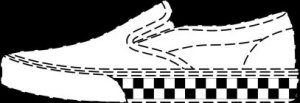I’ve always been fascinated by the outer reaches of trademark protection. These examples of weird things (e.g., Boise State’s blue turf, or the sound of MGM’s roaring lion) make great anecdotes in social settings, and I like using these examples to get clients to think creatively about their branding strategies and what trademark law can protect.
Erik Pelton’s IPelton® blog has a nice post on one example of non-traditional trademarks: shoe designs.

A picture is worth many, many lawyerly words - "Description of Mark: The mark consists of a stylized checkerboard design positioned around the sidewall on the sole of a shoe. The design of a shoe represented by dotted lines is not part of the mark and only serves to show placement of the mark on the goods."
Under the Lanham Act, a trademark is any word, name, symbol, or design, or any combination thereof, used in commerce to identify and distinguish the goods of one manufacturer or seller from those of another and to indicate the source of the goods. See 15 U.S.C. § 1127.
In a lot of ways, the sky’s the limit in terms of the subject matter that can serve as a trademark. It all comes down to whether something serves as an indicator of source. You see blue turf, you think of Boise State football. You see a robin’s egg blue jewelry box, you think of?
In the case of footwear, there are a lot of ways for brands to signal the uniqueness of their product, and for consumers, in turn, to signal their brand loyalty. But when product designs carry as much (sometimes more) cache than the brand name on the tag or box, there is an increasing risk of copycat designs and, thus, litigation. See Christian Louboutin’s woes over red bottom heels and Adidas and Wal-Mart’s dispute over three-stripe designs as examples of how these disputes can play out.
Which is why, for brand owners large and small, it’s important (1) to think creatively about how to expand the scope of their trademarks and (2) to secure the proper protection for these design (or other) marks through trademark registration.

Pingback: Pumped Up Kicks - Elliott & Davis, PC